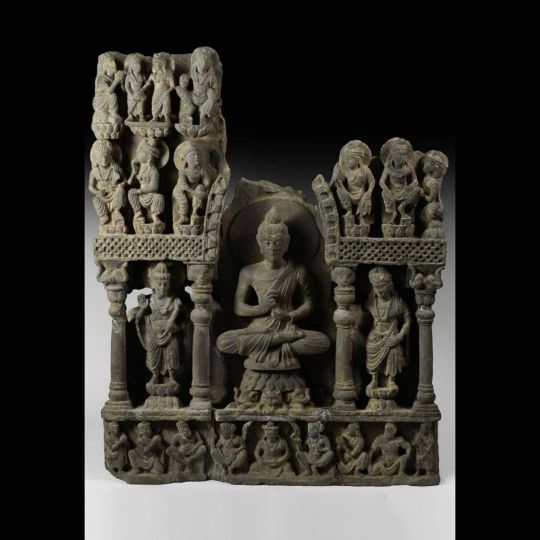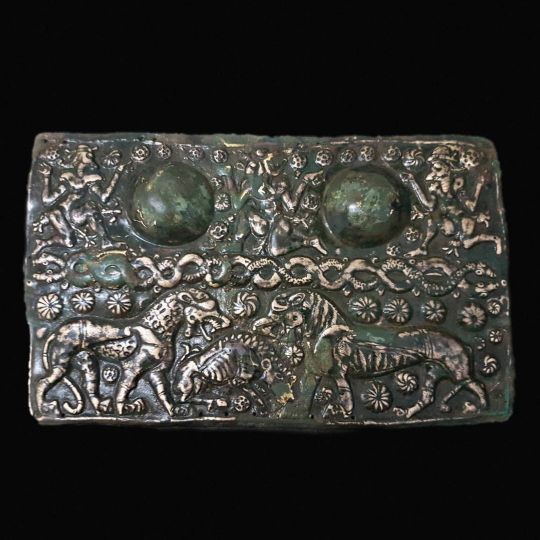#cuneiformwriting
Explore tagged Tumblr posts
Photo

Large Ghandhara plaque Beautiful scene Pakistan 3rd-4th century Previously sold #ancient #ancienthistory #ancientcivilizationn #ancientknowledge #ancientcivilizations #ancientart #ancientartifacts #ancientartifacts #mirandsonsartgallery #ancientarts #ancientneareast #ancienttechnology #cuneiform #cuneiformwriting #sumarian #sumarianrecords #mesopotamia #ancientrome #ancientroman #ancientromans #ancientromanglass #ancientceramics #ancientislamicart https://www.instagram.com/p/CUzGCq8v6m8/?igshid=NGJjMDIxMWI=
#ancient#ancienthistory#ancientcivilizationn#ancientknowledge#ancientcivilizations#ancientart#ancientartifacts#mirandsonsartgallery#ancientarts#ancientneareast#ancienttechnology#cuneiform#cuneiformwriting#sumarian#sumarianrecords#mesopotamia#ancientrome#ancientroman#ancientromans#ancientromanglass#ancientceramics#ancientislamicart
0 notes
Photo

An alabaster fragment of a Mesopotamian vase with cuneiform writing on it (22nd century BC), from @allardpierson in Amsterdam. The writing can be translated as “Shar-Kali-Sharri, king of [the country of] Akkad”. The symbols in the left part of the inscription mean “Agade-ki” (Country of Akkad). The symbols on the right are the name of the Akkadian king Shar-Kali-Sharri (r. circa 2217-2193 BC), the star symbol in the top right corner is a silent (not pronounced) sign to signify divine/divinity and comes from the Sumerian word for god/goddess. Shar-Kali-Sharri was one of the last kings of the Akkadian Empire, that dominated much of Mesopotamia from the late 24th century BC until the mid-22nd century BC. #allardpiersonmuseum #allardpierson #amsterdam #museum #archaeology #archeology #archeologie #alabaster #akkad #akkadian #akkadianempire #mesopotamia #ancient #art #ancientart #cuneiform #cuneiformwriting #writing #king #history #geschiedenis (bij Allard Pierson Museum) https://www.instagram.com/p/CHK-hI8HPh2/?igshid=ucfimgeuymtk
#allardpiersonmuseum#allardpierson#amsterdam#museum#archaeology#archeology#archeologie#alabaster#akkad#akkadian#akkadianempire#mesopotamia#ancient#art#ancientart#cuneiform#cuneiformwriting#writing#king#history#geschiedenis
1 note
·
View note
Photo

Sliver plaque Jirfot period Previously sold at the timelines auction #ancient #ancienthistory #ancientcivilizationn #ancientknowledge #ancientcivilizations #ancientart #ancientartifacts #ancientartifacts #mirandsonsartgallery #ancientarts #ancientneareast #ancienttechnology #cuneiform #cuneiformwriting #sumarian #sumarianrecords #mesopotamia #ancientrome #ancientroman #ancientromans #ancientromanglass #ancientceramics #ancientislamicart https://www.instagram.com/p/CUzFkdKPzz8/?igshid=NGJjMDIxMWI=
#ancient#ancienthistory#ancientcivilizationn#ancientknowledge#ancientcivilizations#ancientart#ancientartifacts#mirandsonsartgallery#ancientarts#ancientneareast#ancienttechnology#cuneiform#cuneiformwriting#sumarian#sumarianrecords#mesopotamia#ancientrome#ancientroman#ancientromans#ancientromanglass#ancientceramics#ancientislamicart
1 note
·
View note
Photo

A worrier sitting on a horse TERAQUIZE GLAZED ceramic Kashan period Early 13th century #ancient #ancienthistory #ancientcivilizationn #ancientknowledge #ancientcivilizations #ancientart #ancientartifacts #ancientartifacts #mirandsonsartgallery #ancientarts #ancientneareast #ancienttechnology #cuneiform #cuneiformwriting #sumarian #sumarianrecords #mesopotamia #ancientrome #ancientroman #ancientromans #ancientromanglass #ancientceramics #ancientislamicart https://www.instagram.com/p/CUzFYmdv7Du/?igshid=NGJjMDIxMWI=
#ancient#ancienthistory#ancientcivilizationn#ancientknowledge#ancientcivilizations#ancientart#ancientartifacts#mirandsonsartgallery#ancientarts#ancientneareast#ancienttechnology#cuneiform#cuneiformwriting#sumarian#sumarianrecords#mesopotamia#ancientrome#ancientroman#ancientromans#ancientromanglass#ancientceramics#ancientislamicart
1 note
·
View note
Photo

Bronze plaque India BC1500 #ancient #ancienthistory #ancientcivilizationn #ancientknowledge #ancientcivilizations #ancientart #ancientartifacts #ancientartifacts #mirandsonsartgallery #ancientarts #ancientneareast #ancienttechnology #cuneiform #cuneiformwriting #sumarian #sumarianrecords #mesopotamia #ancientrome #ancientroman #ancientromans #ancientromanglass #ancientceramics #ancientislamicart https://www.instagram.com/p/CUzFJwBPQ2l/?igshid=NGJjMDIxMWI=
#ancient#ancienthistory#ancientcivilizationn#ancientknowledge#ancientcivilizations#ancientart#ancientartifacts#mirandsonsartgallery#ancientarts#ancientneareast#ancienttechnology#cuneiform#cuneiformwriting#sumarian#sumarianrecords#mesopotamia#ancientrome#ancientroman#ancientromans#ancientromanglass#ancientceramics#ancientislamicart
0 notes
Photo

Beautiful fasting Budhha 3rd–5th century Pakistan #ancient #ancienthistory #ancientcivilizationn #ancientknowledge #ancientcivilizations #ancientart #ancientartifacts #ancientartifacts #mirandsonsartgallery #ancientarts #ancientneareast #ancienttechnology #cuneiform #cuneiformwriting #sumarian #sumarianrecords #mesopotamia #ancientrome #ancientroman #ancientromans #ancientromanglass #ancientceramics #ancientislamicart https://www.instagram.com/p/CUxAtJipNts/?igshid=NGJjMDIxMWI=
#ancient#ancienthistory#ancientcivilizationn#ancientknowledge#ancientcivilizations#ancientart#ancientartifacts#mirandsonsartgallery#ancientarts#ancientneareast#ancienttechnology#cuneiform#cuneiformwriting#sumarian#sumarianrecords#mesopotamia#ancientrome#ancientroman#ancientromans#ancientromanglass#ancientceramics#ancientislamicart
0 notes
Photo

SUMARIAN BRONZE VIOLENT #ancient #ancienthistory #ancientcivilizationn #ancientknowledge #ancientcivilizations #ancientart #ancientartifacts #ancientartifacts #mirandsonsartgallery #ancientarts #ancientneareast #ancienttechnology #cuneiform #cuneiformwriting #sumarian #sumarianrecords #mesopotamia #ancientrome #ancientroman #ancientromans #ancientromanglass #ancientceramics #ancientislamicart https://www.instagram.com/p/CUw_-vsJ0bh/?igshid=NGJjMDIxMWI=
#ancient#ancienthistory#ancientcivilizationn#ancientknowledge#ancientcivilizations#ancientart#ancientartifacts#mirandsonsartgallery#ancientarts#ancientneareast#ancienttechnology#cuneiform#cuneiformwriting#sumarian#sumarianrecords#mesopotamia#ancientrome#ancientroman#ancientromans#ancientromanglass#ancientceramics#ancientislamicart
0 notes
Photo

Beautiful Luristan Sword Bronze age (c. 2900 - 1250 BC ) #ancient #ancienthistory #ancientcivilizationn #ancientknowledge #ancientcivilizations #ancientart #ancientartifacts #ancientartifacts #mirandsonsartgallery #ancientarts #ancientneareast #ancienttechnology #cuneiform #cuneiformwriting #sumarian #sumarianrecords #mesopotamia #ancientrome #ancientroman #ancientromans #ancientromanglass #ancientceramics #ancientislamicart https://www.instagram.com/p/CUw_urFpjvO/?igshid=NGJjMDIxMWI=
#ancient#ancienthistory#ancientcivilizationn#ancientknowledge#ancientcivilizations#ancientart#ancientartifacts#mirandsonsartgallery#ancientarts#ancientneareast#ancienttechnology#cuneiform#cuneiformwriting#sumarian#sumarianrecords#mesopotamia#ancientrome#ancientroman#ancientromans#ancientromanglass#ancientceramics#ancientislamicart
1 note
·
View note
Photo

Ancient Beautiful Artifact #ancient #ancienthistory #ancientcivilizationn #ancientknowledge #ancientcivilizations #ancientart #ancientartifacts #ancientartifacts #mirandsonsartgallery #ancientarts #ancientneareast #ancienttechnology #cuneiform #cuneiformwriting #sumarian #sumarianrecords #mesopotamia #ancientrome #ancientroman #ancientromans #ancientromanglass #ancientceramics #ancientislamicart https://www.instagram.com/p/CUw_pEYJZGZ/?igshid=NGJjMDIxMWI=
#ancient#ancienthistory#ancientcivilizationn#ancientknowledge#ancientcivilizations#ancientart#ancientartifacts#mirandsonsartgallery#ancientarts#ancientneareast#ancienttechnology#cuneiform#cuneiformwriting#sumarian#sumarianrecords#mesopotamia#ancientrome#ancientroman#ancientromans#ancientromanglass#ancientceramics#ancientislamicart
0 notes
Photo

Bronze Canonical Bronze age (c. 2900 - 1250 BC ) #ancient #ancienthistory #ancientcivilizationn #ancientknowledge #ancientcivilizations #ancientart #ancientartifacts #ancientartifacts #mirandsonsartgallery #ancientarts #ancientneareast #ancienttechnology #cuneiform #cuneiformwriting #sumarian #sumarianrecords #mesopotamia #ancientrome #ancientroman #ancientromans #ancientromanglass #ancientceramics #ancientislamicart https://www.instagram.com/p/CUuEreqJgMz/?igshid=NGJjMDIxMWI=
#ancient#ancienthistory#ancientcivilizationn#ancientknowledge#ancientcivilizations#ancientart#ancientartifacts#mirandsonsartgallery#ancientarts#ancientneareast#ancienttechnology#cuneiform#cuneiformwriting#sumarian#sumarianrecords#mesopotamia#ancientrome#ancientroman#ancientromans#ancientromanglass#ancientceramics#ancientislamicart
0 notes
Photo

Beautiful Luristan Sword Bronze age (c. 2900 - 1250 BC ) #ancient #ancienthistory #ancientcivilizationn #ancientknowledge #ancientcivilizations #ancientart #ancientartifacts #ancientartifacts #mirandsonsartgallery #ancientarts #ancientneareast #ancienttechnology #cuneiform #cuneiformwriting #sumarian #sumarianrecords #mesopotamia #ancientrome #ancientroman #ancientromans #ancientromanglass #ancientceramics #ancientislamicart https://www.instagram.com/p/CUuEXdlJNPJ/?igshid=NGJjMDIxMWI=
#ancient#ancienthistory#ancientcivilizationn#ancientknowledge#ancientcivilizations#ancientart#ancientartifacts#mirandsonsartgallery#ancientarts#ancientneareast#ancienttechnology#cuneiform#cuneiformwriting#sumarian#sumarianrecords#mesopotamia#ancientrome#ancientroman#ancientromans#ancientromanglass#ancientceramics#ancientislamicart
0 notes
Photo

Scean of two snakes battling Jiroft period c. 3100 - c. 2200 #ancient #ancienthistory #ancientcivilizationn #ancientknowledge #ancientcivilizations #ancientart #ancientartifacts #ancientartifacts #mirandsonsartgallery #ancientarts #ancientneareast #ancienttechnology #cuneiform #cuneiformwriting #sumarian #sumarianrecords #mesopotamia #ancientrome #ancientroman #ancientromans #ancientromanglass #ancientceramics #ancientislamicart https://www.instagram.com/p/CUuELdXJ0Uh/?igshid=NGJjMDIxMWI=
#ancient#ancienthistory#ancientcivilizationn#ancientknowledge#ancientcivilizations#ancientart#ancientartifacts#mirandsonsartgallery#ancientarts#ancientneareast#ancienttechnology#cuneiform#cuneiformwriting#sumarian#sumarianrecords#mesopotamia#ancientrome#ancientroman#ancientromans#ancientromanglass#ancientceramics#ancientislamicart
1 note
·
View note
Photo

The Mesopotamian tell al-Ubaid painted Figure UR Period c.6500 - c. 3800 BC #ancient #ancienthistory #ancientcivilization #ancientknowledge #ancientcivilizations #ancientart #ancientartifacts #ancientartifacts #mirandsonsartgallery #ancientarts #ancientneareast #ancienttechnology #cuneiform #cuneiformwriting #sumarian #sumarianrecords #mesopotamia #ancientrome #ancientroman #ancientromans #ancientromanglass #ancientceramics #ancientislamicart https://www.instagram.com/p/CUfWqd0pJwD/?igshid=NGJjMDIxMWI=
#ancient#ancienthistory#ancientcivilization#ancientknowledge#ancientcivilizations#ancientart#ancientartifacts#mirandsonsartgallery#ancientarts#ancientneareast#ancienttechnology#cuneiform#cuneiformwriting#sumarian#sumarianrecords#mesopotamia#ancientrome#ancientroman#ancientromans#ancientromanglass#ancientceramics#ancientislamicart
0 notes
Photo

Stone Jiroft Stone Cup c. 3100 - c. 2200 #ancient #ancienthistory #ancientcivilization #ancientknowledge #ancientcivilizations #ancientart #ancientartifacts #ancientartifacts #mirandsonsartgallery #ancientarts #ancientneareast #ancienttechnology #cuneiform #cuneiformwriting #sumarian #sumarianrecords #mesopotamia #ancientrome #ancientroman #ancientromans #ancientromanglass #ancientceramics #ancientislamicart https://www.instagram.com/p/CUfR7NGpl5U/?igshid=NGJjMDIxMWI=
#ancient#ancienthistory#ancientcivilization#ancientknowledge#ancientcivilizations#ancientart#ancientartifacts#mirandsonsartgallery#ancientarts#ancientneareast#ancienttechnology#cuneiform#cuneiformwriting#sumarian#sumarianrecords#mesopotamia#ancientrome#ancientroman#ancientromans#ancientromanglass#ancientceramics#ancientislamicart
0 notes
Photo

Amlash Terracotta Bull Vessel #ancient #ancienthistory #ancientcivilization #ancientknowledge #ancientcivilizations #ancientart #ancientartifacts #ancientartifacts #mirandsonsartgallery #ancientarts #ancientneareast #ancienttechnology #cuneiform #cuneiformwriting #sumarian #sumarianrecords #mesopotamia #ancientrome #ancientroman #ancientromans #ancientromanglass #ancientceramics #ancientislamicart https://www.instagram.com/p/CUfP1qzptem/?igshid=NGJjMDIxMWI=
#ancient#ancienthistory#ancientcivilization#ancientknowledge#ancientcivilizations#ancientart#ancientartifacts#mirandsonsartgallery#ancientarts#ancientneareast#ancienttechnology#cuneiform#cuneiformwriting#sumarian#sumarianrecords#mesopotamia#ancientrome#ancientroman#ancientromans#ancientromanglass#ancientceramics#ancientislamicart
1 note
·
View note
Photo

SUMARIAN BLACK STONE TIGER c. 4500 - 1900 BC #ancient #ancienthistory #ancientcivilization #ancientknowledge #ancientcivilizations #ancientart #ancientartifacts #ancientartifacts #mirandsonsartgallery #ancientarts #ancientneareast #ancienttechnology #cuneiform #cuneiformwriting #sumarian #sumarianrecords #mesopotamia #ancientrome #ancientroman #ancientromans #ancientromanglass #ancientceramics #ancientislamicart https://www.instagram.com/p/CUfPbKbJWt7/?igshid=NGJjMDIxMWI=
#ancient#ancienthistory#ancientcivilization#ancientknowledge#ancientcivilizations#ancientart#ancientartifacts#mirandsonsartgallery#ancientarts#ancientneareast#ancienttechnology#cuneiform#cuneiformwriting#sumarian#sumarianrecords#mesopotamia#ancientrome#ancientroman#ancientromans#ancientromanglass#ancientceramics#ancientislamicart
0 notes